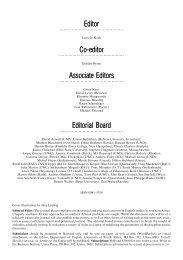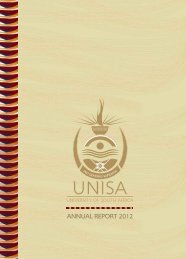pdf: 6.426kb - University of South Africa
pdf: 6.426kb - University of South Africa
pdf: 6.426kb - University of South Africa
Create successful ePaper yourself
Turn your PDF publications into a flip-book with our unique Google optimized e-Paper software.
survival by capturing, controlling and exploiting these<br />
valuable resources. While the overwhelming majority<br />
<strong>of</strong> the population are left to their own fate `between<br />
bare subsistence and violent pillage', the e lite have<br />
been able to link up to the global networks <strong>of</strong> wealth,<br />
power, information, communication and trade. Angola<br />
and Colombia share this commonality though, ironically,<br />
illicit cocaine pr<strong>of</strong>its during the mid-1980s,<br />
brought about a significant boom which construction,<br />
real estate, infrastructural development and investment<br />
in Colombian cities. Cocaine (with foreign<br />
revenues <strong>of</strong> between US$ 3±5 billion annually), have<br />
resulted in Colombia gaining a `hegemonic position'<br />
in a major sector <strong>of</strong> the global criminal economy<br />
(Castells 1998:196±197). Oil and diamonds have<br />
failed to do the same for Angola.<br />
The emphasis should therefore not be on availability,<br />
but on exploitation. For, in the words <strong>of</strong> De<br />
Beers diamond conglomerate chairman, Nicky Oppenheimer:<br />
`natural resources are morally neutral ± the<br />
key element is not the resource itself, but how it is<br />
exploited, which makes the difference between<br />
becoming a curse rather than a blessing' to Angola<br />
(The Mining Journal 19 November 1999:1). Coca<br />
plant cultivation, however, is not morally neutral, but<br />
intended outrightly to serve a highly pr<strong>of</strong>itable illegal<br />
and destructive purpose. It is also a matter <strong>of</strong> demanddriven<br />
and exports oriented economics. Cocaine is<br />
pr<strong>of</strong>itable ± every step along the way ± from coca<br />
cultivation to processing to street selling. A coca<br />
grower earns between US$ 1000 and 10 000 for<br />
enough coca leaves to produce a kilo <strong>of</strong> cocaine<br />
which has a street value <strong>of</strong> US$ 800 000. A hectare <strong>of</strong><br />
coca may yield up to three times the income <strong>of</strong> a<br />
hectare <strong>of</strong> bananas (The Economist 26 February<br />
2000:23). While it is difficult to indicate any specific<br />
price value for uncut diamonds as it depends on the<br />
carat measurement, it is common knowledge that<br />
uncut diamonds are substantially more pr<strong>of</strong>itable than,<br />
for example, c<strong>of</strong>fee or cotton ± primary commodities<br />
being exported by Angola and Colombia. Both coca<br />
(cocaine) and diamonds continue to enjoy a considerable<br />
price advantage over most legal cash crops.<br />
This becomes evident when comparing potential<br />
coca/cocaine earnings with the world market prices<br />
for c<strong>of</strong>fee, cotton and maize (see table 3).<br />
The illegal smuggling <strong>of</strong> diamonds, and coca<br />
cultivation <strong>of</strong>ten provide rural dwellers and subsistence<br />
farmers the best hope <strong>of</strong> escaping a life <strong>of</strong><br />
extreme poverty. They have long abandoned hope <strong>of</strong><br />
making a decent living from legal crops alone. Worse<br />
in the case <strong>of</strong> Angola, the state has largely abandoned<br />
them to care for themselves. Ironically, their shift to<br />
producing (or mining) these lucrative resources in<br />
itself, has become an incentive for guerrillas, paramilitaries,<br />
private `security' firms and narco-traffickers<br />
to violently seek control <strong>of</strong> the areas in which rural<br />
farmers and dwellers engaged in coca cultivation<br />
(Colombia) and diamond mining (Angola). For<br />
example, both the largest concentrations <strong>of</strong> FARC<br />
guerrillas and the biggest expanse <strong>of</strong> coca fields are<br />
located in <strong>South</strong>ern Colombia. Securing `outlets' for<br />
cocaine smuggling, and `inlets' for weapons procurement,<br />
FARC controls about 50 small ports in the Gulf<br />
<strong>of</strong> Uraba (North Pacific Ocean) (Sweeney 1999:4;<br />
Messiant 1998:162±164).<br />
Linking institutional failure to resource exploitation,<br />
it suffices to observe that, in the case <strong>of</strong> Angola, there<br />
is no orderly mining regime, operating within a<br />
transparent and predictable legislative and fiscal<br />
framework ± in fact, there is an almost total absence<br />
<strong>of</strong> `strong imperial statehood' (Sweeney 1999:1;<br />
Buzan 1991; Zacarias 1999). This state <strong>of</strong> affairs has<br />
proved conducive to the capture, control and exploitation<br />
<strong>of</strong> these high value commodities by corrupt,<br />
greedy and power hungry e lite groups. One example is<br />
the rich Catoca diamond mine in North-eastern<br />
Angola, seized from UNITA in 1996, and now<br />
protected by a private security force controlled by a<br />
national army general (International Herald Tribune 7<br />
April 2000:2). Ironically, the MPLA leadership's<br />
comment that `the country's revenues are meant for<br />
resolving the country's problems' has been devoid <strong>of</strong><br />
real meaning to the extent that deprived Angolans<br />
have much reason to view oil and diamond revenues<br />
as a threat to their survival (Global Witness). However,<br />
the resource capture variable is determined by a<br />
complex situation, involving different actors with<br />
TABLE 3<br />
World Market Prices for Selected Commodities<br />
Commodity Unit Price 1996 1997 1998 1999*<br />
C<strong>of</strong>fee (arabica) US$/kg 2,65 4,10 2,90 2,35<br />
Cotton US$/kg 1,77 1,74 1,44 1,29<br />
Maize<br />
US$/metric<br />
ton<br />
165,00 117,00 102,00 93,60<br />
* provisional<br />
Source: IMF's The Primary Commodities Prices<br />
ISSN 0256±6060±Unisa Lat. Am. Rep. 16(2) 2000 27

















